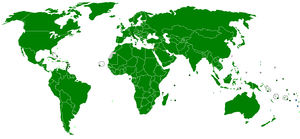Universal Postal Union
|
Union postale universelle Universal Postal Union | |
 | |
|
The UPU flag | |
| Abbreviation | UPU |
|---|---|
| Formation | October 9, 1874 |
| Type | UN agency |
| Legal status | Active |
| Headquarters | Bern, Switzerland |
Head | Bishar Abdirahman Hussein |
| Website | www.upu.int |

The Universal Postal Union (UPU, French: Union postale universelle) is a specialized agency of the United Nations that coordinates postal policies among member nations, in addition to the worldwide postal system. The UPU contains four bodies consisting of the Congress, the Council of Administration (CA), the Postal Operations Council (POC) and the International Bureau (IB). It also oversees the Telematics and EMS cooperatives. Each member agrees to the same terms for conducting international postal duties. The UPU's headquarters are located in Bern, Switzerland.[1]
French is the official language of the UPU. English was added as a working language in 1994. The majority of the UPU's documents and publications – including its flagship magazine, Union Postale – are available in the United Nations' six official languages (French, English, Russian, Mandarin Chinese, Spanish, and Arabic).[2]
Overview

Prior to the establishment of the UPU, each country had to prepare a separate postal treaty with other nations it wished to carry international mail to or from. In some cases, senders would have to calculate postage for each leg of a journey, and potentially find mail forwarders in a third country if there was no direct delivery.[4] To simplify the complexity of this system, the United States called for an International Postal Congress in 1863. This led Heinrich von Stephan, Royal Prussian and later German Minister for Posts, to found the Universal Postal Union. It is currently the third oldest international organization after the Rhine Commission and the ITU. The UPU was created in 1874, initially under the name "General Postal Union", as a result of the Treaty of Bern signed on October 9, 1874.[5] Four years later, the name was changed to "Universal Postal Union."[6]
The UPU established that:
- There should be a uniform flat rate to mail a letter anywhere in the world
- Postal authorities should give equal treatment to foreign and domestic mail
- Each country should retain all money it has collected for international postage.
One of the most important results of the UPU Treaty was that it ceased to be necessary, as it often had been previously, to affix the stamps of any country through which one's letter or package would pass in transit. The UPU provides that stamps of member nations are accepted for the entire international route. Toward the end of the nineteenth century, the UPU issued rules concerning stamp design, intended to ensure maximum efficiency in handling international mail. One rule specified that stamp values be given in numerals (denominations spelled out in letters not being universally comprehensible),[7] another, that member nations all use the same colors on their stamps issued for post cards (green), normal letters (red) and international mail (blue), a system that remained in use for several decades.[8]
After the foundation of the United Nations, the UPU became a specialized agency of the UN in 1948.[9] In 1969, the UPU introduced a new system of payment where fees were payable between countries according to the difference in the total weight of mail between them. These fees were called terminal dues. Ultimately, this new system was fairer when traffic was heavier in one direction than the other. As a matter of example, in 2012, terminal dues for transit from China to the USA was 0.635 SDR/kg, or about 1 USD/kg.[10]
As this affected the cost of the delivery of periodicals, the UPU devised a new "threshold" system, which it later implemented in 1991.[11] The system sets separate letter and periodical rates for countries which receive at least 150 tonnes of mail annually. For countries with less mail, the original flat rate is still maintained. The United States has negotiated a separate terminal dues formula with thirteen European countries that includes a rate per piece plus a rate per kilogram; it has a similar arrangement with Canada. The UPU also operates the system of International Reply Coupons and addresses concerns with ETOEs.
Standards
Standards are important prerequisites for effective postal operations and for interconnecting the global network. The UPU's Standards Board develops and maintains a growing number of international standards to improve the exchange of postal-related information between postal operators. It also promotes the compatibility of UPU and international postal initiatives. The organization works closely with postal handling organizations, customers, suppliers and other partners, including various international organizations. The Standards Board ensures that coherent regulations are developed in areas such as Electronic Data Interchange (EDI), mail encoding, postal forms and meters. UPU standards are drafted in accordance with the rules given in Part V of the "General information on UPU Standards"[12] and are published by the UPU International Bureau in accordance with Part VII of that publication.
Member countries

All United Nations member states are allowed to become members of the UPU. A non-member state of the United Nations may also become a member if two-thirds of the UPU member countries approve its request. The UPU currently has 192 members (190 states and two joint memberships of dependent territories groups).
Member states of the UPU are the Vatican City and the 193 UN members except Andorra, Marshall Islands, the Federated States of Micronesia, and Palau. The newest member is South Sudan, which joined on 4 October 2011.
The overseas constituent countries of the Netherlands (Aruba, Curaçao and Sint Maarten) are represented as a single UPU member as are the entire British overseas territories. These members were originally listed separately as "Colonies, Protectorates, etc." in the Universal Postal Convention[13] and they were grandfathered in when membership was restricted to sovereign states.[14]
Andorra, Marshall Islands, Micronesia and Palau have their mail delivered through another UPU member (France and Spain for Andorra, and the United States for the Compact of Free Association states).[15]
Palestine was granted special observer status to the UPU in 1999, and in 2008 Israel agreed for its mail to be routed through Jordan[16][17] though this had not been implemented as of November 2012.[18]
The Republic of China joined the UPU on 1 March 1914. After the People's Republic of China was founded, the Republic of China continued to represent China in the UPU, until the organization decided on 13 April 1972 to recognize the People's Republic of China as the only legitimate Chinese representative. Because of this, International Reply Coupons are not available for Taiwan. Mail addressed to Taiwan must be delivered through Japan, the United States, or at one point Hong Kong.[19]
The other states with limited recognition, such as Somaliland and the Turkish Republic of Northern Cyprus (TRNC), also route their mail through third countries because the UPU will not allow direct international deliveries. For example, the TRNC's mail goes via Turkey, Somaliland's mail via Ethiopia and Kosovo via Serbia.
Congresses
The Universal Postal Congress is the most important body of the UPU. The main purpose of the quadrennial Congress is to examine proposals to amend the Acts of the UPU, including the UPU Constitution, General Regulations, Convention and Postal Payment Services Agreement. The Congress also serves as forum for participating member countries to discuss a broad range of issues impacting international postal services, such market trends, regulation and other strategic issues. The first UPU Congress was held in Bern, Switzerland in 1874. Delegates from 22 countries participated. UPU Congresses are held every four years and delegates often receive special philatelic albums produced by member countries covering the period since the previous Congress.
Philatelic activities
The Universal Postal Union, in conjunction with the World Association for the Development of Philately, developed the WADP Numbering System (WNS). It was launched on 1 January 2002. The website[20] displays entries for 160 countries and emitting postal entities, with over 25,000 registered stamps since 2002. Many of them have images, which generally remain copyrighted by the issuing country, but the UPU and WADP permit them to be downloaded.
Electronic telecommunication
In some countries, telegraph and later telephones came under the same government department as the postal system. Similarly there was an International Telegraph Bureau, based in Bern, akin to the UPU.[21] The International Telecommunication Union currently facilitates international electronic communication.
In order to integrate postal services and the Internet, the UPU sponsors .post.[22][23] Developing their own standards, the UPU expects to unveil a whole new range of international digital postal services, including e-post. They have appointed a body, the .post group (DPG) to oversee the development of that platform.[24]
See also
References and sources
- References
- ↑ "The UPU". Universal Postal Union website. Retrieved 12 December 2010.
- ↑ "Languages". Universal Postal Union. Retrieved 9 October 2011.
- ↑ A postage stamp honoring the sculptor and the monument was issued jointly by Switzerland and France.
- ↑ Beam, Christopher. (2007-01-05) How international mail works. Slate.com. Retrieved on 2014-04-28.
- ↑ Willoughby, Martin (1992). A History of Postcards. London England: Bracken Books. p. 31. ISBN 1858911621.
- ↑ "About History". Universal Postal Union. Retrieved 16 December 2010.
- ↑ King, Beverly; Johl, Max (1937). The United States Postage Stamps of the Twentieth Century, Volume I. H. L. Lindquist., p. 104
- ↑ "1898 Universal Postal Union Colors #279-284". Kenmore Stamp Company. Retrieved 2013-09-28.
- ↑ "About UN Specialized Agency". Universal Postal Union. Retrieved 9 October 2011.
- ↑ Terminal dues and transit charges 2010–2013 cycle
- ↑ Adams, Cecil (December 12, 1990). "Why Does the US Deliver Foreign Mail When We Don't Get Any Money for the Stamps?". The Straight Dope. Retrieved 16 December 2010.
- ↑ "UPU Postal Standardization Activities" (PDF). UPU. 2008. Retrieved 18 December 2010.
- ↑ "Universal Postal Convention". Universal Postal Union. 1952-07-11. Retrieved 2012-08-11.
- ↑ "Constitution of the Universal Postal Union". Universal Postal Union. 1964-07-10. Retrieved 2012-08-11.
- ↑ Gough, JP (October 6, 2005). "The Evolution of the Postal Service in the Era of the UPU". Web Mavin. Retrieved 12 December 2010.
- ↑ "Palestinian parcel post gets a boost". Universal Postal Union (UPU). Retrieved 2010-09-26.
- ↑ "Israel and Palestinians to boost postal services with help from UN agency". Un.org. Retrieved 2008-10-24.
- ↑ New resolution adopted on Palestinian postal operations | UPU Archived April 29, 2014, at the Wayback Machine.. News.upu.int (2012-03-22). Retrieved on 2014-04-28.
- ↑ 萬國郵政聯盟與世界郵政日 Archived October 16, 2014, at the Wayback Machine.
- ↑ WnsStamps Website
- ↑ "THE CABLE QUESTION.". The Brisbane Courier. National Library of Australia. 15 February 1900. p. 5. Retrieved 16 April 2011.
- ↑ "About .post". Universal Postal Union. Retrieved 3 October 2014.
- ↑ "IANA — .post Domain Delegation Data". Iana.org. Retrieved 3 October 2014.
- ↑ Gustavo Damy (19 September 2014). "Expression of Interest" (PDF). Universal Postal Union. Retrieved 3 October 2014.
- Sources
- Codding, G.A. (1964). The Universal Postal Union : coordinator of the international mails. New York: New York University Press.
- "General Postal Union; October 9, 1874". The Avalon Project at Yale Law School. The Lillian Goldman Law Library in Memory of Sol Goldman. Retrieved 2008-04-05.
External links
| Wikimedia Commons has media related to Universal Postal Union. |
| Wikisource has original text related to this article: |
Coordinates: 46°56′20″N 7°28′31″E / 46.93881°N 7.475306°E
